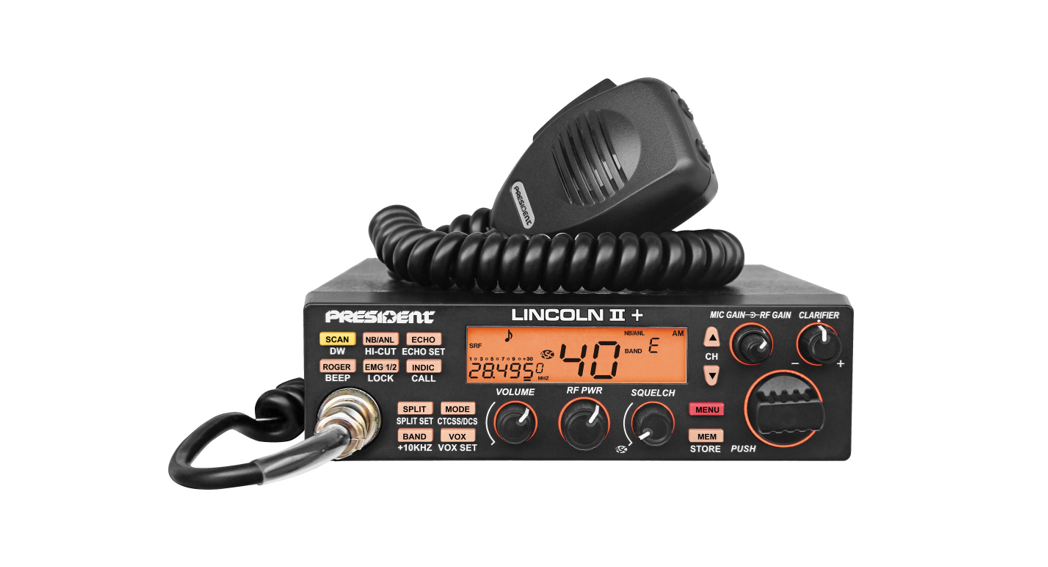
![]()
![]() 0700
0700![]()

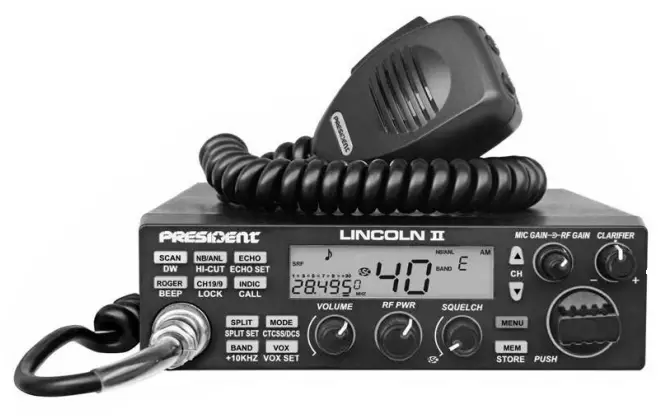
Owner’s manual
Votre PRESIDENT LINCOLN II ASC en un coup d’œil
Un vistazo a vuestro PRESIDENT LINCOLN II ASC
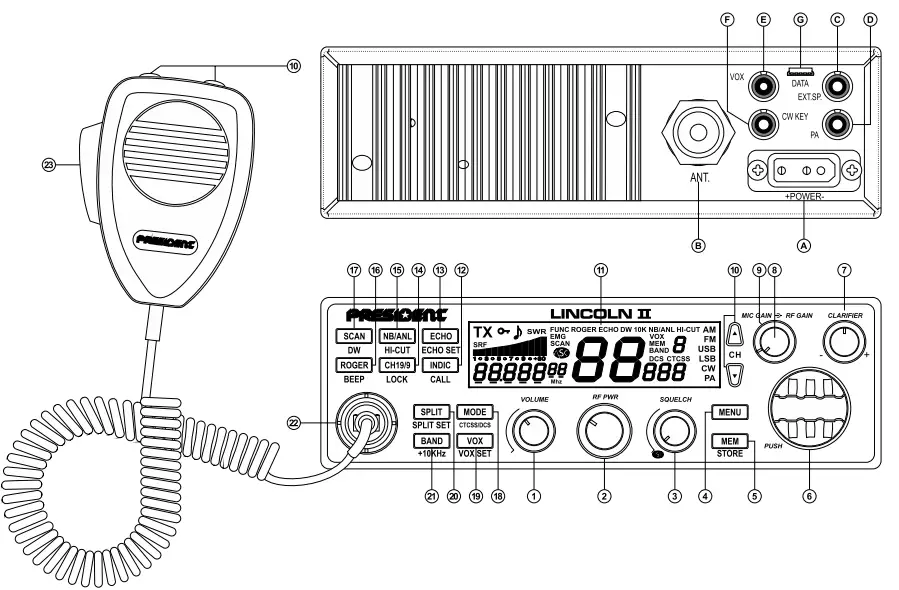
Your PRESIDENT LINCOLN II ASC at a glance
WARNING !
- The use of this equipment involves the possession of a Radio Amateur license
- Before using, be careful never to transmit without first having connected the antenna (connection “B” situated on the back panel of the equipment) or without having set the SWR (Standing Wave Ratio)! Failure to do so may result in the destruction of the power amplifier, which is not covered by the guarantee.
The guarantee of this transceiver is valid only in the country of purchase.
Welcome to the world of the new generation of transceiver radios. The new PRESIDENT range gives you access to top-performance transceiver equipment. With the use of up-to-date technology, which guarantees unprecedented quality, your PRESIDENT LINCOLN II ASC is a new step in personal communication and is the surest choice for the most demanding of radio amateur users. To ensure that you make the most of all its capacities, we advise you to read carefully this manual before installing and using your PRESIDENT LINCOLN II ASC.
INSTALLATION
1) WHERE AND HOW TO MOUNT YOUR TRANSCEIVERa) You should choose the most appropriate setting from a simple and practical point of view.b) Your transceiver radio should not interfere with the driver or the passengers.c) Remember to provide for the passing and protection of different wires (e.g. power, antenna, accessory cabling) so that they do not in any way interfere with the driving of the vehicle.d) To install your equipment, use the cradle (1) and the self-tapping screws (2) provided (drilling diameter 3.2 mm). Take care not to damage the vehicle’selectrical system while drilling the dashboard.
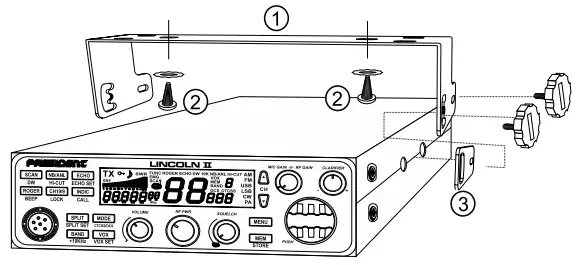
e) Do not forget to insert the rubber joints (3) between the transceiver and its support as these have a shock-absorbing effect which permits gentle oriental-tion and tightening of the set.f) Choose where to place the microphone support and remember that the microphone cord must stretch to the driver without interfering with the controlsof the vehicle.
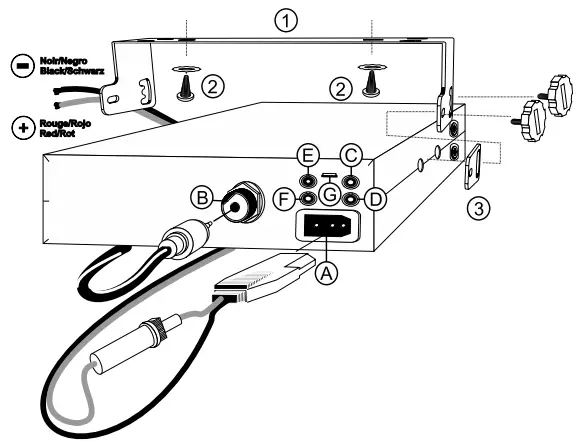
– N.B.: As the transceiver has a frontal microphone socket, it can be set into the dashboard. In this case, you will need to add an external loudspeaker toimprove the sound quality of communications (connector EXT SP situated on the back panel: C). Ask your dealer for advice on mounting your transceiverradio.
2) ANTENNA INSTALLATIONa) Choosing your antenna– For transceiver radios, the longer the antenna, the better its results. Your dealer will be able to help you with your choice of antenna.b) Mobile antenna– Must be fixed to the vehicle where there is a maximum of metallic surface (ground plane), away from windscreen mountings.– If you already have a radio-telephone antenna installed, the transceiver antenna should be higher than this.– There are two types of antenna: pre-regulated which should be used on a good ground plane (e.g. car roof or lid of the boot), and adjustable whichoffer a much larger range and can be used on a smaller ground plane (see§ HOW TO ADJUST SWR, below).– For an antenna that must be fixed by drilling, you will need good contact between the antenna and the ground plane. To obtain this, you should lightlyscratch the surface where the screw and tightening star are to be placed.– Be careful not to pinch or flatten the coaxial cable (as this runs the risk of break down and/or short-circuiting).– Connect the antenna (B).c) Fixed antenna– A fixed antenna should be installed in a clear a space as possible. If it is fixed to a mast, it will perhaps be necessary to stay it, according to the laws in force (you should seek professional advice). All PRESIDENT antennas and accessories are designed to give maximum efficiency to each transceiver radio within the range.
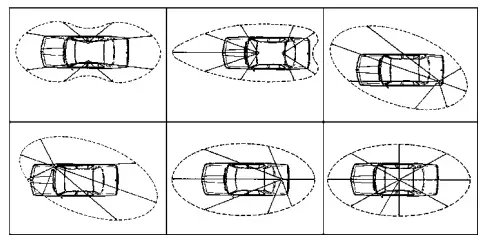
OUTPUT RADIUS PATTERN
OUTPUT RADIUS PATTERN3) POWER CONNECTIONYour PRESIDENT LINCOLN II ASC is protected against an inversion of polarities. However, before switching it on, you are advised to check all the connections. Your equipment must be supplied with a continuous current of 12 volts(A). Today, most cars and lorries are negative earth. You can check this by making sure that the negative terminal of the battery is connected either to the engine block or to the chassis. If this is not the case, you should consult your dealer.WARNING: Lorries generally have two batteries and an electrical installation of 24 volts, in which case it will be necessary to insert a 24/12 volt converter(type CV 24/12 PRESIDENT) into the electrical circuit. The following connection steps should be carried out with the power cable disconnected from the set.a) Check that the battery is of 12 volts.b) Locate the positive and negative terminals of the battery (+ is red and – is black). Should it be necessary to lengthen the power cable, you should usethe same or a superior type of cable.c) It is necessary to connect your transceiver to a permanent (+) and (-). We advise you to connect the power cable directly to the battery (as theconnection of the transceiver cable to the wiring of the car radio or other parts of the electrical circuit may, in some cases, increase the likelihood ofinterference).d) Connect the red wire (+) to the positive terminal of the battery and the black (-) wire to the negative terminal of the battery.e) Connect the power cable to your transceiver radio.WARNING: Never replace the original fuse (6 A) with one of a different value.

4) BASIC OPERATIONS TO BE CARRIED OUT BEFORE USINGYOUR SET FOR THE FIRST TIME (without transmitting and without using the “push-to-talk” switch on the microphone)a) Connect the microphoneb) Check the antenna connectionsc) Turn the set on by turning the volume knob (1) clockwise.d) Turn the squelch SQUELCH knob (3) to minimum.e) Adjust the volume to a comfortable level.f) Go to channel 20 by using s![]() keys (10).
keys (10).
5) HOW TO ADJUST SWR (Standing Wave Ratio) With the integrated SWR meter:Put the unit into AM or FM with the MODE key (18). Using PUSH knob (6), ![]()
![]()
![]()
![]()
![]()
![]()
![]()
![]()
![]()
![]()
![]()
![]()
![]()
![]()
![]()
![]()
HOW TO USE YOUR TRANSCEIVER
1) ON/OFF ~ VOLUMETurn on the radio: clockwise turn VOLUME knob (1) until the radio emits a beep and shows the current channel, radio is on. Turn Off radio: counterclockwise turn VOLUME knob (1)until radio emits click sound, then radio is off. Volume Adjustment: Radio is on, rotate VOLUME knob (1) to adjust the volume. LCD shows “UOLXX” for 5 seconds which means volume level. Total is 36 levels. Clockwise to increase volume. Counterclockwise to decrease volume.
2) RF POWERIn TX, rotate RF PWR knob (2) to adjust FM/AM/USB/LSB output power. Clockwise to increase power. Counterclockwise to decrease power.
3) ASC (Automatic Squelch Control) – SQUELCHSuppresses undesirable background noises when there is no communication. Squelch affect neither sound nor transmission power, but allows a considerable Improvement In listening comfort.
a) ASC: AUTOMATIC SQUELCH CONTROLWorldwide patent, a PRESIDENT exclusivity. Turn the SQUELCH knob (3) anticlockwise Into ASC position. “ASC” appears on the LCD. No repetitive manual adjustment and a permanent Improvement between the sensitivity and the listening comfort when ASC is active. This function can be disconnected by turning the switch clockwise. In this case, the squelch adjustment becomes manual again. “ASC” disappears from the LCD. “59L on” appears for 5 seconds.
b) MANUAL SQUELCHTurn the SQUELCH knob clockwise to the exact point where all background noise disappears. This adjustment should be done with precision as, if set to medium(fully clockwise), only the strongest signal will be received. LCD shows “59L LCC for 5 seconds which means squelch volume level. Total is 36 levels.
4) MENUPress the MENU key (4) for 2 seconds to enter in the menu function setting.“FUNC” appears on the LCD.Use![]()
![]()
![]()
![]()
![]()
![]()
![]()
![]()
![]()
![]()
![]()
![]()
![]()
![]()
![]()
![]()
5) MEM ~ STOREMEM (short press)Press MEM key (5) to enter into Memory Mode. Press ![]()
![]()
![]()
![]()
![]()
![]()
![]()
![]()
![]()
![]()
![]()
![]()
![]()
![]()
![]()
![]()
STORE (long press)Select desired channel, band, and modulation mode. Long press MEM-STORE key (5) to enter into Channel Storage Setting, memoryblinks in the LCD. Rotate PUSH knob (6) to select the storage memory n1 ~ n6. Long press MEM-STORE key (5) until blinking memory disappeared. Storagefinished and exit Channel Storage Setting.
6) ROTARY “PUSH” KNOBIn POWER ON status, rotate the PUSH knob (6) to adjust the frequency. Clockwise to increase, counterclockwise to decrease. Press PUSH knob (6), “-” displayed under frequency which means adjust frequency’s stepping. Push or rotating the PUSH knob (6) is also used to set functions or parameters.
7) CLARIFIERThis CLARIFIER knob (7), allows a frequency deviation during the reception in order to improve the clearness of your correspondent’s voice.
8) MIC GAINIn POWER ON status, rotate MIC GAIN knob (8) to adjust microphone gain. LCD shows “nIC XX” for 5 seconds which means microphone gain level. Totalis 36 levels Clockwise to increase, counterclockwise to decrease. In PA status, rotate the MIC GAIN knob (8) to adjust the volume. LCD shows “nIC XX” for 5 seconds which means microphone volume level. Total is 36 levels. Clockwise to increase, counterclockwise to decrease.
9) RF GAINIn RX, rotate RF GAIN knob (9) to adjust RX gain. Clockwise to increase, counterclockwise to decrease.
10)![]()
![]()
![]()
![]()
![]()
![]()
![]()
![]()
![]()
![]()
![]()
![]()
![]()
![]()
![]()
![]()
![]()
![]()
![]()
![]()
![]()
![]()
![]()
![]()
![]()
![]()
![]()
![]()
![]()
![]()
![]()
![]()
![]()
![]()
![]()
![]()
![]()
![]()
![]()
![]()
![]()
![]()
![]()
![]()
![]()
![]()
![]()
![]()
![]()
![]()
![]()
![]()
![]()
![]()
![]()
![]()
![]()
![]()
![]()
![]()
![]()
![]()
![]()
![]()
11) LCD
TX Indicates transmission
![]()
![]()
![]()
![]()
![]()
![]()
![]()
SWR on TX, bargraph shows Standing Wave Ratio (SWR) and value (see INDIC function following)
ROGER ROGER BEEP function is activated
ECHO ECHO function is activated
DW DUAL WATCH activated
10K Frequency +10K function is activated
NB NB filter activated
ANL ANL filter activated
HI-CUT HI-CUT filter activated
EMG The emergency channel 9 or 19 activated
SCAN SCAN function activated
![]()
![]()
VOX VOX function activated
MEM Memorised frequency is selected
DCS DCS code is used
crcss CTCSS tone is used
| AM | AM mode selected |
| FM | FM mode selected |
| USB | USB mode selected |
| LSB | LSB mode selected |
| CW | CW mode selected |
| PA | PA (Public Address) mode selected |
| Shows the channel number | |
| Shows the current Band | |
| Shows DCS code or CTCSS tone | |
| Shows the frequency and menu values |
12) INDIC ~ CALLINDIC (short press)Press INDIC key (12) to display current voltage, shown as![]()
![]()
![]()
CALL (long press)
Press INDIC-CALL key (12) every time to send pre-editing prompt voice code calling. LCD shows “TX”. (see § CALL FREQUENCY, page ).
13) ECHO – ECHO SET
ECHO (short press)
Press ECHO key (13) to enable/disable ECHO function. LCD shows “ECHO”. ECHO SET (long press)
Press ECHO-ECHO SET key (13) to set ECHO VOLUME level and ECHO TIME. “ECHO” blinks on the LCD.
Press ![]()
![]()
![]()
![]()
![]()
![]()
![]()
![]()
![]()
![]()
![]()
![]()
![]()
![]()
![]()
![]()
![]()
![]()
![]()
![]()
![]()
![]()
![]()
![]()
![]()
14) CH9/19 — LOCKCH9/19 (snort press)Press CH19/9 key (14) to enter Emergency Channel. LCD shows “EMG”. First time to select channel 19, second time for channel 9, third time to go back to current channel.LOCK (long press)Long press CH 19/9-LOCK key (14) to enable key LOCK function. LCD shows “![]()
![]()
![]()
![]()
![]()
![]()
![]()
![]()
- NB/ANL — HI-CUT NB/ANL (short press)3 positions switch Off • NB (NB filter activated) • NB/ANL (both filters activated). When active, the filter is displayed on the LCD.NB: Noise Blanker / ANL: Automatic Noise Limiter. These filters allow reducing background noises and some reception interferences.HI–CUT (long press)HI-CUT: Cuts out the high-frequency interferences and has to be used in accordance with the reception conditions. When active “HI-CUT” is displayed on the LCD.
16) ROGER — BEEP ROGER BEEP (short press)
Press the ROGER key (16) to enable/disable the ROGER BEEP function. “ROGER” appears on the LCD when the function is active.
The Roger Beep sounds when the PTT pedal (23) of the microphone is released in order to let your correspondent speak. Historically as transceiver is a “simplex” communication mode, it is not possible to speak and to listen at the same time (as is the case with a telephone). Once someone had finished talking, he said “Roger” in order to prevent his correspondent that it was his turn to talk. The word “Roger” has been replaced by a significant beep. There comes Roger° beep” from.
KEY BEEP (long press)
Press the ROGER-BEEP key (16) for 2 seconds to enable/disable the KEY BEEP function.
A beep sounds when the key is pressed, changing the channel, etc. “![]()
![]()
![]()
17) SCAN – DW
SCAN (short press)
Press SCAN key (17) to enable SCAN function. LCD shows “SCAN”. The scanning stops as soon as there is a busy channel. In SCANNING, press![]()
![]()
![]()
![]()
![]()
![]()
![]()
![]()
![]()
![]()
![]()
![]()
![]()
![]()
![]()
![]()
Press SCAN key (17) again or PTT pedal (23) to exit scan.
DUAL WATCH (long press)
This function allows surveying between the channel set on in the![]()
![]()
Long press SCAN-DW key (17) to enable DW function. LCD shows “DW”. Long press SCAN-DW key (17) again or PTT pedal (23) to exit DW function.
18) MODE — CTCSS/DCS MODE (short press)
Press MODE key (18) to select the modulation mode: AM – FM – USB LSB CW or PA. Corresponding mode is displayed on the LCD.
Your modulation mode has to correspond to the one of your correspondent.
– Frequency Modulation / FM: for nearby communications on a flat open field. – Amplitude Modulation / AM: communication on a field with relief and obstacles at a middle distance (the most used).
– Upper and Lower Side Band / USB-LSB: used for long-distance communications (according to the propagation conditions).
– CW is used with a morse key on the CW KEY jack on the back panel (F).
– An external loudspeaker can be connected to your LINCOLN II by the PA
jack plug situated on the back panel PA.SP (D). The message transmitted
into the microphone will be directed towards the external speaker and be
amplified. See § MIC GAIN page 31 for adjustment of volume.
CTCSS/DCS (long press)
This function Is only enabled In FM modulation
Long press MODE-CTCSS/DCS key (18) to enable CTCSS tone or DCS code. “CTCSS” or “DCS” blinks on the LCD.
Rotate PUSH knob (6) to set desired CTCSS tone. There are 38 CTCSS tones from C Ito 38.
Continue to rotate PUSH knob (6) to set desired DCS code. There are 104 DCS codes from CO Ito IOW.
Select Hoff” for disabling the CTCSS tone or DCS code.
Press MEM/STORE (5) for 2 seconds to store the CTCSS tone or DCS code. Long press MODE-CTCSS/DCS key (18) to disable CTCSS tone or DCS code.
See tables on page 52
19) VOX VOX SET VOX (snort press)
The VOXfunction allows transmitting by speaking into the original microphone (or in the optional vox microphone) without pressing the PTT pedal (23). In the case of the use of an optional vox mike connected to the rear panel of the radio – VOX MIC jack (E), the original microphone doesn’t work.
Press the VOX key (19) in order to activatethe VOXfunction. “VOX” is displayed on the LCD. A new pressure on the VOX key (19) switches the function oft. “VOX”disappears from the LCD.
VOX SET (long press)
Press for 2 seconds the VOX-VOX SET key (19) in order to activate the VOX SET function (if the VOX function is oft, this will turn the function on and display “VOX” on the LCD). ![]()
![]()
![]()
Three features are possible: Sensitivity level, Anti-Vox level, and Vox Delay time. Press A/y keys (10) in order to select the following feature. LCD shows the feature. Rotate PUSH (6) to set the feature. Press MEM/STORE key (5) to store and skip into the next feature. Once the adjustments are done, press the VOX-VOX SET key (19) in order to quit the VOX SET function. If any adjustments have been done during 5 seconds, the transceiver will quit the VOX SET function automatically.
– Sensitivity![]()
![]()
![]()
– Anti-Vox ![]()
![]()
– Delay Time![]()
![]()
20) SPLIT — SPLIT SET
SPLIT (short press)The SPL/T function allows to transmit and receive on separated frequencies. Press SPLIT key (20) to enable repeater function, LCD shows ![]()
![]()
![]()
![]()
SPLIT SET (long press)
Long press SPLIT-SPLIT SET key (20) to set repeater’s OFFSET and DIRECTION Press ![]()
![]()
![]()
![]()
![]()
![]()
![]()
![]()
![]()
![]()
![]()
![]()
![]()
![]()
![]()
![]()
DIRECTION: LCD shows “SPL. E”.”-!t” in LCD means positive offset set in current channel, “–” means negative offset set in current channel.
21) BAND — +10KHz
BAND (short press)
Press BAND key (21) for quick movement skipping 200 A ~ B ~ C ~ D ~ E~ F ~ 9 ~ H ~ I segments.
+10KHz (long press)
Long press BAND-+ I OKHz key (21) to enable frequency +10KHZ. LCD shows “10K “
Long press BAND-+1OKHz key (21) again to disable frequency +10KHZ. “10K” disappears from the LCD.
22) 6 PIN MICROPHONE PLUG
The plug is located on the front panel of the transceiver and makes the setting of the equipment into the dashboard easier.
See Cabling Diagram page 52.
23) PTTTransmission key, press to transmit a message, “TX” is displayed, and release to listen to incoming communication.A) DC-POWER TERMINAL (13,2 V)B) ANTENNA CONNECTOR (SO-239)C) EXTERNAL SPEAKER JACK (8 Ω, Ø 3,5 mm)D) JACK FOR OPTIONAL PA (Public Address) (Ø 3.5 mm)E) JACK FOR OPTIONAL VOX MIKE (Ø 2.5 mm)F) JACK FOR CW DEVICE (Ø 3.5 mm)G) USB DATA
C) MENU FUNCTIONSPress the MENU key (4) for 2 seconds to enter in the menu function setting. “FUNC” appears on the LCD.Use![]()
![]()
![]()
![]()
![]()
![]()
![]()
![]()
![]()
![]()
![]()
![]()
![]()
![]()
![]()
![]()
1) ROGER BEEP FREQUENCY
Set the FREQUENCY of the ROGER BEEP.
At![]()
![]()
![]()
2) ROGER BEEP TIME
Set the TIME (ms) of the ROGER BEEP.
At![]()
![]()
![]()
Time range so – Iwo ms, time stepping: so ms, default: soo ms. Press PUSH knob (6) to change the step.
3) CW FREQUENCY
Set the FREQUENCY of the CW.
At![]()
![]()
4) CALL FREQUENCYSet the FREQUENCY of the CALL tone. At the![]()
![]()
5) MONITOR GAIN VOLUMESet the OUTPUT VOLUME LEVEL of the microphone in your own speaker. At ![]()
![]()
6) TOT (Time Out Timer)Set the TOT. If the PTT pedal (23) is pressed for more than “TOT” time, the transmission ends. At ![]()
![]()
7) SWR PROTECTIONEnable/disable the SWR PROTECTION. At ![]()
![]()
8) SWR PROTECTION SETTINGSet the SWR LEVEL PROTECTION. At ![]()
![]()
![]()
9) VOLTAGE PROTECTIONEnable/disable VOLTAGE PROTECTION. At![]()
![]()
![]()
10) VOLTAGE PROTECTION HIGHSet the HIGHER LIMIT of VOLTAGE PROTECTION. At ![]()
![]()
11) VOLTAGE PROTECTION LOWSet the LOWER LIMIT of VOLTAGE PROTECTION. At ![]()
![]()
![]()
12) SCAN TYPE
Select the TYPE of SCAN. At ![]()
![]()
![]()
![]()
![]()
13) BACKLIGHT COLOR
Select the BACKUGHT COLOR of the unit.
At ![]()
![]()
![]()
![]()
![]()
![]()
![]()
![]()
14) BACKLIGHT BRIGHTNESS
Adjust the BACKUGHT BRIGHTNESS of the unit. At![]()
![]()
15)![]()
![]()
![]()
![]()
![]()
![]()
![]()
![]()
![]()
![]()
![]()
![]()
![]()
![]()
![]()
![]()
Select the ![]()
![]()
![]()
![]()
![]()
![]()
![]()
![]()
![]()
![]()
![]()
![]()
![]()
![]()
![]()
![]()
![]()
![]()
![]()
![]()
![]()
![]()
Note: If FREQUENCY Is selected. Press PUSH knob (6) to select the frequency digit to be increased by the ![]()
![]()
![]()
![]()
![]()
![]()
![]()
![]()
![]()
![]()
![]()
![]()
![]()
![]()
![]()
![]()
16) DW SETTING
Set the CHANNEL use with the DUAL WATCH function. At![]()
![]()
17) RESETInitialization of the unit. At ![]()
![]()
![]()
![]()
![]()
![]()
![]()
![]()
TECHNICAL CHARACTERISTICS
| 1) GENERAL | |
| – Modulation modes | : AM / FM / USB / LSB / CW |
| – Frequency ranges | : from 28.000 MHz to 29.700 MHz |
| – Antenna impedance | : 50 ohms |
| – Power supply | : 13.2 V |
| – Dimensions (in mm) | : 170 (W) x 250 (D) x 52 (H) |
| – Weight | : 1,4 kg |
| – Accessories supplied | : microphone UP/DOWN with support, mounting cradle, screws, and fused power cord. |
| 2) TRANSMISSION | |
| – Frequency allowance | : +/- 300 Hz |
| – Carrier power | : 12 W AM / 28 W FM /
31 W USB-LSB (PEP) / 12 W CW |
| – Transmission interference | : inferior to – 50 dBc |
| – Audio response | : 300 Hz to 3 KHz in AM/FM/USB/LSB |
| – Emitted power in the adj. channel | : inferior to 20 μW |
| – Microphone sensitivity | : 3.0 mV |
| – Drain | : 6 A (with modulation) |
| – Modulated signal distortion | : 2 % |
| 3) RECEPTION | |
| – Maxi. sensitivity at 20 dB sinad
|
: 0.7 μV – 110 dBm (AM)
0.35 μV – 116 dBm (FM) 0.28 μV – 118 dBm (USB/LSB/CW) |
| – Frequency response | : 300 Hz to 3 kHz in AM/FM/LSB/USB |
| – Adjacent channel selectivity | : 60 dB |
| – Maximum audio power | : 3 W |
| – Squelch sensitivity | : minimum 0.2 μV – 120 dBm
maximum 1 mV – 47 dBm |
| – Frequency image rejection rate | : 60 dB |
| – Intermediate frequency rej. rate | : 70 dB |
| – Drain | : 400 mA nominal / 600 mA maximum |
E) TROUBLE SHOOTING1) YOUR transceiver RADIO WILL NOT TRANSMIT OR YOURTRANSMISSION IS OF POOR QUALITY– Check that the antenna is correctly connected and that the SWR is properly adjusted.– Check that the microphone is properly plugged in.2) YOUR transceiver RADIO WILL NOT RECEIVE OR RECEPTIONIS POOR– Check that the squelch level is properly adjusted.– Check that the volume is set to a comfortable listening level.– Check that the antenna is correctly connected and that the SWR is properly adjusted.– Check that you are using the same modulation mode as your correspondent.3) YOUR transceiver WILL NOT LIGHT UP– Check the power supply.– Check the connection wiring.– Check the fuse.
F) GLOSSARYINTERNATIONAL PHONETIC ALPHABET
A AlphaB BravoC CharlieD DeltaE EchoF FoxtrottG GolfH HotelI IndiaJ JuliettK KiloL LimaM MikeN NovemberO OscarP PapaQ QuebecR RomeoS SierraT TangoU UniformV VictorW WhiskeyX X-rayY YankeeZ Zulu
CERTIFICATE OF CONFORMITYWe, GROUPE PRESIDENT ELECTRONICS, Route de Sète, BP 100 – 34540 Balaruc – FRANCE, Declare, on our own responsibility that the transceiver radiocommunication transceiver
Brand: PRESIDENTModel: LINCOLN II
is in conformity with the essential requirements of the Directive 1999/5/CE (Article 3) adapted to the national law, as well as with the following European Standards:
EN 301 783 – 1EN 301 783 – 2EN301 489 – 15EN 60950 – 1 (2006) + A11 (2009)
and is in conformity with Directive RoHS2: 2011/65/EU (2011/06/08).
Balaruc, the 2013/12/16
![]()
![]()
Jean-Gilbert MULLERGeneral Manager
GENERAL WARRANTY CONDITIONS
This device is guaranteed 2 years of parts and labor in its country of purchase against any manufacturing defects validated by our technical department. *The After-sales Service of PRESIDENT reserves the right not to apply the warranty if a breakdown is caused by an antenna other than those distributed by PRESIDENT, and if the said antenna is at the origin of the breakdown. An extension of 3 years warranty is proposed systematically for the purchase and use of a PRESIDENT antenna, bringing the total duration of the warranty to 5 years. In order to be valid, the warranty certificate must be returned within a period of 30 days after the purchase date to the After-sales Service of the company Groupe President Electronics, or any foreign subsidiary.
It is recommended to carefully read the following conditions and to respect them under penalty of losing their benefit.
- To be valid the warranty certificate must be returned to us at the latest 1 month after the purchase.
- Please duly complete the warranty certificate on the right-hand side of the page, detach it (portion to be removed marked by dotted line) and send it back.
- Any repair under warranty will be free and the return delivery costs will be borne by our company.
- A purchase proof must be necessarily included with the device to be repaired.
- The dates listed on the warranty certificate and proof of purchase must match.
- Do not proceed with the installation of the device without reading the user manual.
- No spare part will be sent nor exchanged by our services under warranty.
The warranty is only valid in the country of purchase.
Exclusions (are not covered):
- Damages caused by accident, shock, or inadequate packaging.
- Power transistors, microphones, lights, fuses, and the non-respect of the installation and use of specifications (including but not limited to the antenna used with too high power, final output power transistors (SWR), inversion of polarities, bad connections, overvoltage,….)
- The warranty cannot be extended due to the non-availability of the device while it is being servicedat our technical services location, nor by a change of one or more components or spare parts.
- Transceivers which have been modified. The warranty application is excluded in case of modification or poor maintenance done by a third party not approved by our company.
If you note malfunctions:
- Check the power supply of your device and the quality of the fuse.
- Check that the antenna, the microphone…. are correctly connected.
- Check that the squelch level is properly adjusted; the programmed configuration is the correct one…
- In case the device is not under warranty, the repair and return of the device will be charged.
- All related documents must be preserved even after the end of the warranty period and if you resell your device, given to the new owner for the After-sales follow-up.
- In case of a real malfunction, please contact your dealer first; they will decide the action to be taken.
- In case of an intervention not covered by the warranty, an estimate will be established before any repair.
Thank you for your trust in the PRESIDENT quality and experience. We recommend that you read this manual carefully so that you are completely satisfied with your purchase. Do not forget to return the detachable warranty certificate on the right-hand side of this page; it is very important for the identification of your device during a possible rendering of our services.
![]()
![]()
Date of purchase • ………………………………………………………………………….
Type: Radio Amateur LINCOLN II
Serial N°: ……………………………………………………………………………………….


NOT COVERED BY THE WARRANTY WITHOUT THE DEALER STAMP
6-PIN MICROPHONE PLUG
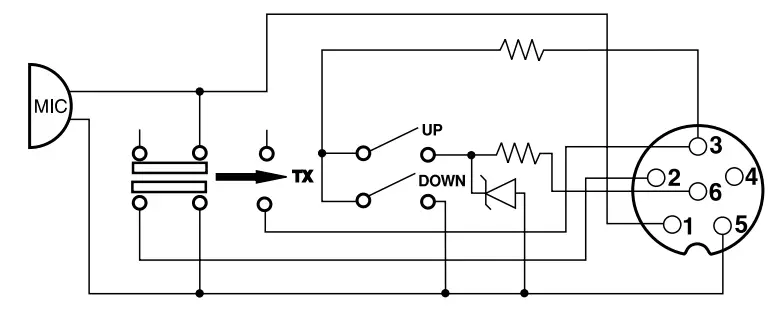

- Modulation
- RX
- TX – UP/DOWN
- _
- Ground
- Power Supply
CTCSS TONES LIST
| No. | Freq. (Hz) | No. | Freq. (Hz) | No. | Freq. (Hz) |
| 00 -0F | OFF | 13 | 103.5 | 26 | 162.2 |
| 01 | 67.0 | 14 | 107.2 | 27 | 167.9 |
| 02 | 71.9 | 15 | 110.9 | 28 | 173.8 |
| 03 | 74.4 | 16 | 114.8 | 29 | 179.9 |
| 04 | 77.0 | 17 | 118.8 | 30 | 186.2 |
| 05 | 79.7 | 18 | 123.0 | 31 | 192.8 |
| 06 | 82.5 | 19 | 127.3 | 32 | 203.5 |
| 07 | 85.4 | 20 | 131.8 | 33 | 210.7 |
| 08 | 88.5 | 21 | 136.5 | 34 | 218.1 |
| 09 | 91.5 | 22 | 141.3 | 35 | 225.7 |
| 10 | 94.8 | 23 | 146.2 | 36 | 233.6 |
| 11 | 97.4 | 24 | 151.4 | 37 | 241.8 |
| 12 | 100.0 | 25 | 156.7 | 38 | 250.3 |
DCS CODE LIST
| CodeNo. | DCS(Octal) | CodeNo. | DCS(Octal) | CodeNo. | DCS(Octal) | CodeNo. | DCS(Octal) |
| 1 | 023 | 27 | 152 | 53 | 311 | 79 | 466 |
| 2 | 025 | 28 | 155 | 54 | 315 | 80 | 503 |
| 3 | 026 | 29 | 156 | 55 | 325 | 81 | 506 |
| 4 | 031 | 30 | 162 | 56 | 331 | 82 | 516 |
| 5 | 032 | 31 | 165 | 57 | 332 | 83 | 523 |
| 6 | 036 | 32 | 172 | 58 | 343 | 84 | 526 |
| 7 | 043 | 33 | 174 | 59 | 346 | 85 | 532 |
| 8 | 047 | 34 | 205 | 60 | 351 | 86 | 546 |
| 9 | 051 | 35 | 212 | 61 | 356 | 87 | 565 |
| 10 | 053 | 36 | 223 | 62 | 364 | 88 | 606 |
| 11 | 054 | 37 | 225 | 63 | 365 | 89 | 612 |
| 12 | 065 | 38 | 226 | 64 | 371 | 90 | 624 |
| 13 | 071 | 39 | 243 | 65 | 411 | 91 | 627 |
| 14 | 072 | 40 | 244 | 66 | 412 | 92 | 631 |
| 15 | 073 | 41 | 245 | 67 | 413 | 93 | 632 |
| 16 | 074 | 42 | 246 | 68 | 423 | 94 | 654 |
| 17 | 114 | 43 | 251 | 69 | 431 | 95 | 662 |
| 18 | 115 | 44 | 252 | 70 | 432 | 96 | 664 |
| 19 | 116 | 45 | 255 | 71 | 445 | 97 | 703 |
| 20 | 122 | 46 | 261 | 72 | 446 | 98 | 712 |
| 21 | 125 | 47 | 263 | 73 | 452 | 99 | 723 |
| 22 | 131 | 48 | 265 | 74 | 454 | 100 | 731 |
| 23 | 132 | 49 | 266 | 75 | 455 | 101 | 732 |
| 24 | 134 | 50 | 271 | 76 | 462 | 102 | 734 |
| 25 | 143 | 51 | 274 | 77 | 464 | 103 | 743 |
| 26 | 145 | 52 | 306 | 78 | 465 | 104 | 754 |


SIEGE SOCIAL/HEAD OFFICE – FRANCESite Internet: http://www.president-electronics.comE-mail: [email protected]
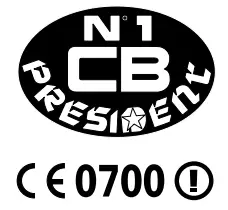



1409/12-13
References
[xyz-ips snippet=”download-snippet”]

